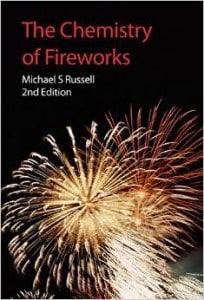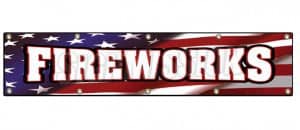Summertime is almost here and what can be more summer-like than the 4th of July, picnics, parades and, most of all, fireworks! Come see our new fireworks display and get in the mood for summer!
Fireworks have a long and, dare I say, colorful history. Fireworks go back as far as 7th century China. In 1292 Marco Polo took fireworks back to Italy where the Italians began to develop them as an art form. Settlers brought fireworks to the Americas in the 1600s, and the very first 4th of July celebration with fireworks was in 1777 – a year after the Declaration of Independence was signed. The earliest patents for fireworks go back as far as 1876.
There are a multitude of different fireworks, but they fall into three categories. Aerial fireworks include mortars, bottle rockets and Roman candles. Proximate fireworks are often used indoors for concerts, theatrical presentations and movies. Ground-based fireworks include the familiar firecrackers, snakes, smoke bombs, and sparklers.

The beautiful colors of the fireworks come from various chemical compounds: red is strontium and lithium; blue is copper; silver or white is burning aluminum titanium and magnesium; orange is calcium; yellow is sodium; green is barium; and the neon green and turquoise are chlorine with barium or copper. Different chemicals also affect the appearance of fireworks in different ways. For example, aluminum creates the sparkler effect, glitter comes from antimony, calcium deepens the color, phosphorous creates glow in the dark effects and the smoke effects come from zinc.
Sound is also influenced by the chemicals used and by the shape of the firework tube. Perhaps surprisingly, the whistle effect is second only to flash powders in being the most hazardous firework effect. Whistle combinations consist of potassium chlorate or potassium perchlorate as the oxidizer, with a salt of benzoic acid or a substituted benzoic acid. You’ll notice you see the fireworks before you hear the booms. That’s because light travels about a million times faster than sound. Those loud booms are actually sonic booms caused by the expansion of gases. You can calculate how far from the fireworks you are by counting the seconds from the time you see the firework until you hear the boom. To figure the distance in miles simply multiply the number of seconds by .o2.
There are, not surprisingly, many safety regulations surrounding the production and handling of fireworks, but there are also interesting regulations for the storage of fireworks. One of the hazards of storing fireworks is static electricity. Staff working in explosive buildings should not wear synthetic clothing or non-conducting footwear. Personnel should also discharge themselves before entering the building with an electrostatic discharger. There are also regulations for conduction, anti-static flooring and the humidification of the room.
Before safety regulations were enacted there were many accidents resulting in casualties. When the Treaty of Aix-la Chapelle was signed in 1748 celebrations were held all over Europe. The celebration in Paris had a mass explosion which led to the death of 40 people and over 300 injuries. It was 1875 before the Explosives Act was introduced. The current Federal Explosives Law and Regulations is from 2012. Each state also regulates the use and availability of fireworks.
George Frederick Handel was commissioned to write an overture for the London celebration of the Treaty of Aix-la-Chapelle. He wrote Music for the Royal Fireworks, and this began the tradition of association between music and fireworks. For more information about creating fireworks displays and their environmental impact, check out Fireworks displays: explosive entertainment, by Dr. Tom Smith.

So, when and why were fireworks banned in Iowa? Fireworks were banned in 1937, following two incidents. In Spencer, Iowa someone lit fireworks in a store where they were being sold. That 1931 fire destroyed most of the downtown. Then, in 1936, a similar fire in Remen, Iowa caused about $600,000 in damages. Iowa’s ban includes all fireworks except sparklers, toy snakes and caps.
Want to try to make your own (safe) fireworks for the 4th of July? Make: has instruction for making your own Soda Bottle Rocket LED Fireworks! Check out Make: v.41 (2014:Oct./Nov.) or the Make website.
So, whatever your plans are for the 4th of July, check out our exhibit and have a safe 4th full of fun and fireworks!
Resources:
Conkling, John A. Chemistry of pyrotechnics : basic principles and theory. 2nd Edition. 2011. Boca Raton, FL : CRC Press. Engineering Library TP300 .C65 2011.

Soltis, Greg. When was the 4th of July first celebrated. Nov. 28, 2012. LiveScience.
Types of fireworks. FireworksLand. Date Accessed: May 2015
Wolcher, Natalie. How do fireworks make shapes. July 1, 2011. LiveScience.
Allain, Rhett. The awesome physics in a simple sparkler. July, 4, 2014. Wired.
Helmenstine, Anne Marie. Chemistry of firework colors. Feb. 20, 2015. About Education.
Helmenstine, Anne Marie. Elements in fireworks. Dec. 5, 2014. About Educaton
Pappas, Stephanie. 5 fantastic fireworks facts. July 1, 2012. Live Science
Wolchover, Natalie. How do fireworks make shapes. July 1, 2011. Live Science.
De Antonis, Kathy. Fire. October 2010. ChemMatters.
Agrawal, J. P. (Jai Prakash). 2010. High energy materials : propellants, explosives and pyrotechnics. Weinheim : Wiley-VCH. Engineering Library TP267.5 .A57 2010
Smith, Thomas A.K. 2011. Firework displays : explosive entertainment. [Revere, MA] : Chemical Pub. Co. Engineering Library TP300 .F57 2011
McLeod, Stacey. 10 fun facts you probably didn’t know about fireworks. Cottage Life. Date Accessed: May 2015.
How much does Disney spend annually for fireworks? Disneyquestions.com Date Accessed: May 2015. (not available as of 10/10/18)
Which fireworks are legal and prohibited in Iowa and Illinois. July 3, 2014. WQAD8 Quad Cities.
ATF Federal explosives law and regulations. 2012. U.S. Department of Justice.
More Resources:
Philip, Chris. A bibliography of firework books : works on recreative fireworks from the sixteenth to the twentieth century. 1985. Wincester, Hampshire : Published by C. Philip, in association with St. Paul’s Bibliographies. Main Library Z5885 .P48 1985
Russell, Michael S. The chemistry of fireworks. 2009. Cambridge, UK : RSC Pub. Engineering Library TP300 .R$87 2009.
The sound of fireworks – whistles. 2015. Learn Chemistry, Royal Society of Chemistry.
Fireworks Glossary. UK Firework Review. Date Accessed: May 2015.
The Unexcelled Fireworks Company. July 2, 2013. Letterology.
“Underwater fireworks” reaction of chlorine and acetylene. December 17, 2012. YouTube.
Chemical of the week: fireworks! scifun.org. Date Accessed May 2015.
The awesome physics in a simple sparkler. July 4, 2014. WIRED.
